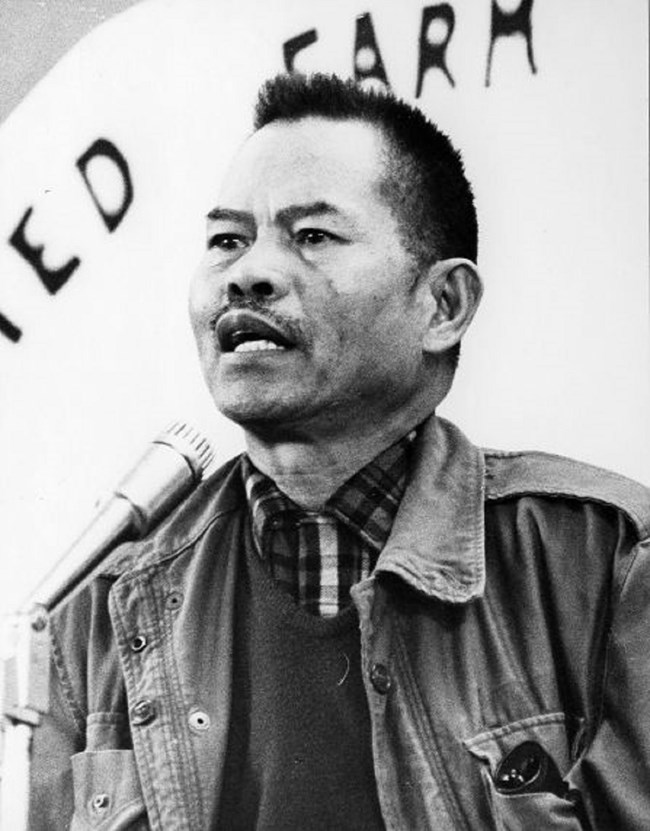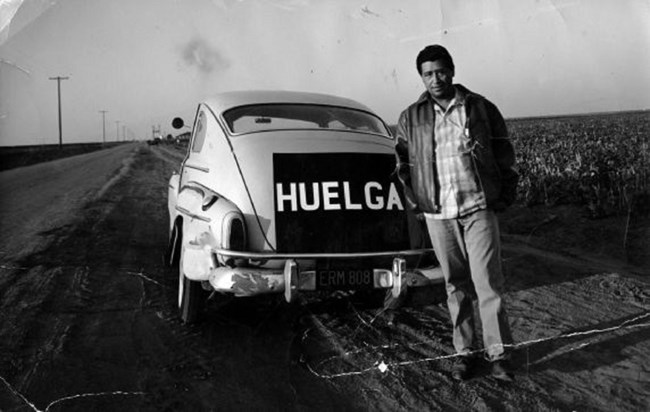Part of a series of articles titled The Road to Sacramento: Marching for Justice in the Fields.
Article
A New Era of Farmworker Organizing

Walter P. Reuther Library, Archives of Labor and Urban Affairs, Wayne State University.
In the early 1960s, the economic, political, and legal landscape of farm work and farmworker organizing changed dramatically. The Bracero Program ended, strikes became more common, and the Black Freedom Movement emerged as a powerful force for social change. This article explores how workers and organizers, like Cesar Chavez, Dolores Huerta, and Larry Itliong, responded to - and shaped - the massive societal shifts underway.
The Bracero Program ended in 1964. This was a result of decades of activism by farmworkers, labor organizers, religious groups, and the braceros themselves, who protested unfair treatment by their employers. Although the Bracero Program was originally enacted as a temporary wartime measure to fill labor shortages in agricultural work, it lasted nearly two decades beyond the war’s end through a series of short-term extensions enacted by Congress. Activists like Ernesto Galarza had begun organizing workers to protest the abuses of the Bracero Program as early as the late 1940s, and the program met with organized resistance whenever Congress considered its renewal. A wave of strikes from 1959 to 1962, involving both domestic farmworkers and braceros, further galvanized this coalition in its ongoing efforts to persuade Congress to end the guestworker program. The mobilization of a broad base of public support was critical to ending the Bracero Program; before long, it would also become a key strategy of the farmworker movement.
Central to these efforts was the Agricultural Workers Organizing Committee (AWOC), an AFL-CIO-chartered union whose mostly Filipino membership included many veterans of the farm worker uprisings of the 1930s and 1940s. The tireless efforts of AWOC organizers like Larry Itliong put the farmworker struggle in the national spotlight. As the Civil Rights Movement flourished in the South, the farmworkers’ efforts in the West gained national support as part of the broader struggle for social justice.
The termination of the Bracero Program empowered farmworkers to press their demands for higher wages through a series of strikes and labor disputes, many of which the workers won. But farmworkers remained outmatched when they challenged growers on longer-term issues like union representation, safety, and pay. Lacking legal protections, they faced intense retaliation for any attempts at collective action, risking not only their jobs, but also their housing, which was often owned by their employers. Growers could also count on the support of local law enforcement and the courts to issue injunctions against strikers and have them arrested. Finally, growers could quickly replace striking workers with “scabs” or strikebreakers, diminishing the economic pressure of the strike.
Still, even with these challenges, the victory against the Bracero Program emboldened farmworkers to continue challenging their unfair treatment. The AWOC channeled this energy into a series of farmworker strikes in the 1960s. At roughly the same moment, Cesar Chavez and Dolores Huerta founded the National Farm Workers Association (NFWA). In September 1962, an inaugural convention took place in Fresno, with almost 300 farm workers coming together to launch the organization. Growing out of Chavez’s earlier work with the Community Services Organization (CSO), the NFWA held central the principle of organizing not only the workers themselves, but entire communities around issues of social justice. Its presence greatly expanded organizing efforts among Mexican American farmworkers in California. In 1965, these two organizations, the NFWA and AWOC, came together in the Delano Grape Strike, catalyzing a new farmworker organizing movement.

Walter P. Reuther Library, Archives of Labor and Urban Affairs, Wayne State University.
Building a Movement
Cesar Chavez moved to Delano with his family in 1962 to build a farmworkers’ union. For more than a decade, he had been organizing farmworkers with the Community Service Organization (CSO), a civil rights group focused on building political power in the Mexican American community. In the CSO, Chavez developed skills as a community organizer that would later be critical to the success of the farmworker movement. During his time with the CSO, Chavez was particularly concerned with the plight of farmworkers. He carefully documented the abuses of the Bracero Program in his efforts to organize Mexican Americans. The CSO was not a labor organization, but it was critical to Chavez's later efforts to organize farmworkers. Chavez envisioned a union that addressed both the issues specific to workers and the broad-based social issues that affected the entire community. It was this vision that brought him to Delano in 1962.
Chavez knew firsthand the challenges farmworkers faced in building a movement. Born in Arizona in 1927, he entered the migrant circuit with his family when they lost their farm in 1939, in the midst of the Great Depression. After serving in the military in the late 1940s, Chavez worked at a sawmill. In 1952, he met Father Donald McDonnell, who introduced Chavez to Catholic social activism, a guiding principle of Chavez's work with the CSO and a foundation of the later farmworker movement. But Chavez was not alone in his efforts to build a better life for farmworkers. When he began to mobilize the National Farm Workers Association, he was building on decades of farmworker organizing. Now, in the midst of the Civil Rights Movement, it seemed that the farmworkers’ moment had - at long last - arrived.
Bibliography
Bardacke, Frank. Trampling out the Vintage : Cesar Chavez and the Two Souls of the United Farm Workers. New York: Verso, 2011.
Jenkins, J. Craig. The Politics of Insurgency: The Farm Worker Movement in the 1960s. New York: Columbia University Press, 1985.
Levy, Jacques E., and Chávez, Cesar. Cesar Chávez: Autobiography of La Causa. 1st ed. New York: Norton, 1975.
Scharlin, Craig, and Lilia V. Villanueva. Philip Vera Cruz. 3rd ed. University of Washington Press, 2011.
Last updated: March 20, 2025
